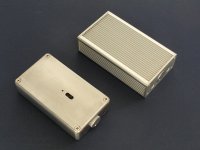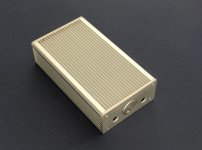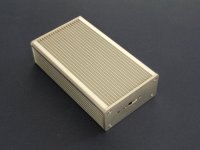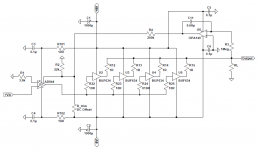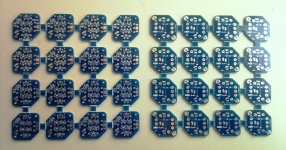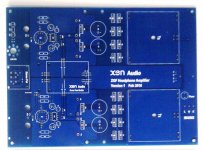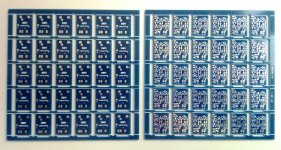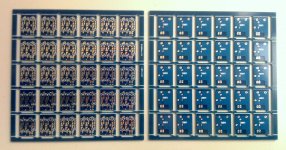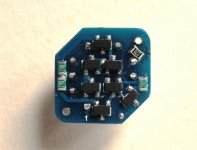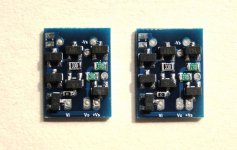As posted here a while ago :
http://www.diyaudio.com/forums/pass-labs/271926-f5-headamp-9.html#post4601780
I built a portable headamp for my own use during travelling.
This is designed to drive a pair of Sennheiser HD25-Aluminium phones with 70 ohm impedance.
Because it has to be portable, it is battery driven and hence is limited in current consumption.
It also has to be compact, which is why I used IC’s by and large.
You can read about the design details here :
http://xen-audio.com/documents/xen-zgf/XEN ZGF Portable Description V1.pdf
(ZGF = Zero Global Feedback)
Patrick
http://www.diyaudio.com/forums/pass-labs/271926-f5-headamp-9.html#post4601780
I built a portable headamp for my own use during travelling.
This is designed to drive a pair of Sennheiser HD25-Aluminium phones with 70 ohm impedance.
Because it has to be portable, it is battery driven and hence is limited in current consumption.
It also has to be compact, which is why I used IC’s by and large.
You can read about the design details here :
http://xen-audio.com/documents/xen-zgf/XEN ZGF Portable Description V1.pdf
(ZGF = Zero Global Feedback)
Patrick
The first prototype was build using a Hammond 1550 die cast box, which was shortened by 4mm.
It also has no servo (only R trim) and no cross feed, and a gain of 5.
The DC offset was adjusted to < 5mV.
For the second prototype, we found a heatsink extrusion, and CNC machined the front and rear panels.
It is however slightly larger, and somewhat heavier (by the weight of two batteries).
It has full features -- servo, cross feed, and a gain of 10.
Patrick
.
It also has no servo (only R trim) and no cross feed, and a gain of 5.
The DC offset was adjusted to < 5mV.
For the second prototype, we found a heatsink extrusion, and CNC machined the front and rear panels.
It is however slightly larger, and somewhat heavier (by the weight of two batteries).
It has full features -- servo, cross feed, and a gain of 10.
Patrick
.
Attachments
Hi,
I so much like the schematic of this headamp; 4xBUF634 means 1A which is great. I wonder how it will work with +/-15V on rails...I'm pretty sure it should drive all headphones out there, planars included.
By looking at the graphs it has quite a flat response up to 100KHz, but is there any chance of A/B comparing it with a well known neutral amp perhaps?
BTW, wouldn't be cheaper to parallel 2xLM4900 or 2xOPA633/ch. and to get the same output impedance as well?
Thanks,
Raul.
P.S.: I really liked your transistors (miss)matched article from your website. Thank you for the info!
I so much like the schematic of this headamp; 4xBUF634 means 1A which is great. I wonder how it will work with +/-15V on rails...I'm pretty sure it should drive all headphones out there, planars included.
By looking at the graphs it has quite a flat response up to 100KHz, but is there any chance of A/B comparing it with a well known neutral amp perhaps?
BTW, wouldn't be cheaper to parallel 2xLM4900 or 2xOPA633/ch. and to get the same output impedance as well?
Thanks,
Raul.
P.S.: I really liked your transistors (miss)matched article from your website. Thank you for the info!
For a portable amp with a compact size, 2x DPAK (LM49600, etc.) take up too much PCB area.
And DPAK is difficult to stack and to get rod of the heat at the same time.
At +/-15V, it is becoming not a portable, but a desk top amp.
But we like the sound of this so much, that we are contemplating a desk top version.
Still takes some time for the ideas to mature.
Patrick
And DPAK is difficult to stack and to get rod of the heat at the same time.
At +/-15V, it is becoming not a portable, but a desk top amp.
But we like the sound of this so much, that we are contemplating a desk top version.
Still takes some time for the ideas to mature.
Patrick
The R_trim is essentially for offset correction at Pin 5 (Tz).
The same applies to the servo, which in this case acts as a <1Hz current source to create a voltage offset through the 20k resistor at Tz.
We have an alternative version, including an extension to desk top, on the drawing board which is very interesting.
But it either uses an NOS LH0033, or a discrete version of the same.
So we did not want to publish this as the standard version, which should be with currently available parts.
Patrick
The same applies to the servo, which in this case acts as a <1Hz current source to create a voltage offset through the 20k resistor at Tz.
We have an alternative version, including an extension to desk top, on the drawing board which is very interesting.
But it either uses an NOS LH0033, or a discrete version of the same.
So we did not want to publish this as the standard version, which should be with currently available parts.
Patrick
Crossfeed
I like the circuit concept very much. So much so that I'm seriously considering a slightly larger version with DIPs and batteries for desktop use.
The crossfeed is puzzling me, though. I'm looking at Danyuk's article from Electronics World, and having trouble matching up the schematic with the BOM. I'd guess your implementation does not include the pots, and maybe has a couple extra resistors for the buffer transistors, but could you provide a hint as to the what RC values are used where? Perhaps a PM would be appropriate. And if you can't, that's cool too.
I like the circuit concept very much. So much so that I'm seriously considering a slightly larger version with DIPs and batteries for desktop use.
The crossfeed is puzzling me, though. I'm looking at Danyuk's article from Electronics World, and having trouble matching up the schematic with the BOM. I'd guess your implementation does not include the pots, and maybe has a couple extra resistors for the buffer transistors, but could you provide a hint as to the what RC values are used where? Perhaps a PM would be appropriate. And if you can't, that's cool too.
You can find our version of the Danyuk here :
http://www.diyaudio.com/forums/head...ss-zgf-headphone-amplifier-5.html#post4437573
http://www.diyaudio.com/forums/pass-labs/271926-f5-headamp-7.html#post4551110
http://www.diyaudio.com/forums/head...ss-zgf-headphone-amplifier-4.html#post4436996
I have replaced all the pots with fixed resistors after finding the setting I like.
The XEN ZGF desk top version will be using a LH0033 with a pair of Sanken TO220 BJT's biased at 150mA.
Patrick
http://www.diyaudio.com/forums/head...ss-zgf-headphone-amplifier-5.html#post4437573
http://www.diyaudio.com/forums/pass-labs/271926-f5-headamp-7.html#post4551110
http://www.diyaudio.com/forums/head...ss-zgf-headphone-amplifier-4.html#post4436996
I have replaced all the pots with fixed resistors after finding the setting I like.
The XEN ZGF desk top version will be using a LH0033 with a pair of Sanken TO220 BJT's biased at 150mA.
Patrick
Last edited:
You can find our version of the Danyuk here:
Thank you. I thought I read the F5 doc today, but evidently not long enough to make it to the crossfeed section.
The XEN ZGF desk top version will be using a LH0033 with a pair of Sanken TO220 BJT's biased at 150mA.
Very interested. The idea of two noiseless 9V batteries has tremendous appeal, but the brute force of 150ma is equally seductive. Choices, choices...
Thanks again for the info.
Mike
You should be thinking of +/-15V for the desk top version.
Battery is still viable with enough listening time.
But the 317/337 followed by cap multiplier as in F5-HA is dead quiet anyhow.
So battery option is only for "portability".
Unlike the portable version here, that is.
Patrick
Battery is still viable with enough listening time.
But the 317/337 followed by cap multiplier as in F5-HA is dead quiet anyhow.
So battery option is only for "portability".
Unlike the portable version here, that is.
Patrick
Just received PCBs for the desktop version, based largely on the F5-HA layout.
It uses a pair of LH0033 combined with Sanken complementary BJTs to form a Sziklai output stage.
And to make sure anyone can build this without NOS devices, I also designed a LH0033 replacement PCB of the same footprint.
This uses 2SK208GR and 2SC3324BL / 2SA1312BL to resemble the original circuit.
Patrick
.
It uses a pair of LH0033 combined with Sanken complementary BJTs to form a Sziklai output stage.
And to make sure anyone can build this without NOS devices, I also designed a LH0033 replacement PCB of the same footprint.
This uses 2SK208GR and 2SC3324BL / 2SA1312BL to resemble the original circuit.
Patrick
.
Attachments
The first prototype of a discrete LH0033 works first time. 
It uses low noise transistors 2SK208GR, 2SC3324BL and 2SA1812BL, all matched.
The offset can be easily trimmed to below 1mV.
The foot pin is identical to the original device, without saying.
A 16x16mm IC heat sink can be stacked on top for thermal coupling between devices.
Patrick
.
It uses low noise transistors 2SK208GR, 2SC3324BL and 2SA1812BL, all matched.
The offset can be easily trimmed to below 1mV.
The foot pin is identical to the original device, without saying.
A 16x16mm IC heat sink can be stacked on top for thermal coupling between devices.
Patrick
.
Attachments
Last edited:
- Status
- This old topic is closed. If you want to reopen this topic, contact a moderator using the "Report Post" button.
- Home
- Amplifiers
- Headphone Systems
- XEN ZGF Portable Headphone Amplifier
